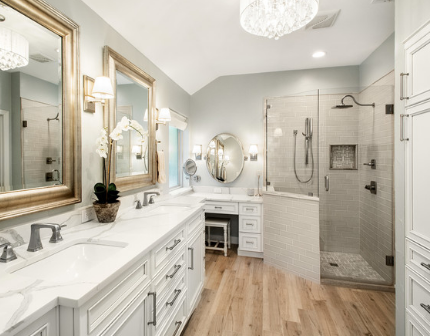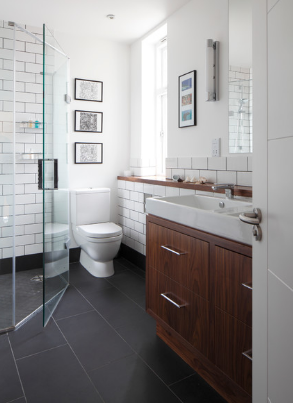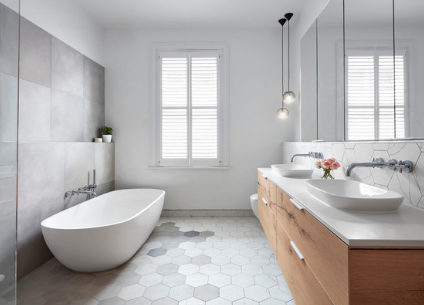
The material, shape, and design of floor tiles have a big impact on the look and feel of your bathroom. Although issues such as cost, durability, and everyday practicality will undoubtedly guide you, it can be difficult for you to make a decision with such a dizzying array of options today. To help you out, we’ve highlighted some of the best floor tile options for stylish bathrooms everywhere.

Large light tawny tiles create a neutral and serene classic look. Their generous size and light color palette also enhance the sense of space. Large tiles mean fewer grout lines that need to be maintained and kept mold-free.
Combine them with matching wall tiles to create a simple style that never seems to go out of style. Look for limestone, travertine, or tiles in pink-brown or yellow-brown hues, and always make sure they are non-slip and suitable for the bathroom.

Tiles that look like wooden planks are becoming more and more popular, and it’s easy to see why. Using solid wood in the bathroom can be risky, as moisture can cause damage. Wood grain floor tiles have the warmth and beauty of wood while being practical, waterproof, and sturdy. They come in shades ranging from gray to reddish-brown, so choose a color that matches the rest of your home’s style and color scheme.

We’re getting braver and braver when it comes to adding patterns to the floor. Vintage or Moroccan-style tiles look great in the bathroom. It provides a striking contrast to the all-white room, which means that the rest of the room doesn’t have to struggle to look stylish. Here, a beautiful vintage-looking pattern is paired with a black border to set the foundation for the design and add a traditional touch.
Handmade cement bricks look gorgeous, but they can be expensive and need to be sealed. Fortunately, ceramic and porcelain patterned tiles can produce similar effects.

Now there are some cool geometric tiles that can also make the bathroom feel special. It’s always a good idea to take some samples home and think about how the pattern will repeat before making a decision. The tile has a fairly large diamond pattern, so a reasonable amount of visible floor area is required to appreciate it. The black and white geometric design also looks great with the colors, as they do here with the sleek blue wall tiles.

Simple slate-looking black tiles are a practical and timeless choice for the bathroom, as they hide dirt and are durable. They can also make white fixtures and walls look more interesting.
Real slate is beautiful, durable, and non-slip, but it is expensive and needs to be sealed regularly. Plus, it’s cold underfoot, which can be a problem in the winter – although most types of stone and tiles work well with radiant underfloor heating systems. If you want a more affordable alternative, consider slate-style tiles and choose one with a matte finish and an uneven surface to make it look more realistic.

The rectangular tiles commonly found in bathrooms and kitchens are undergoing a subtle change in favor of squares with a Scandinavian style. The small beige tiles here are quiet and delicate – larger than mosaics, and less crowded. They create a soft contrast with the mosaics around the bathtub and the rectangular tiles near the windows. They can be good if you want tiles that don’t look too outdated quickly.

The classic light limestone has a beautiful appearance and gives the impression of light and space to the bathroom. When you come out of the tub, the real limestone also feels lovely underfoot: smooth and not too cold.
However, because limestone is porous, it needs to be carefully maintained and sealed to prevent moisture from entering. If this is an issue, you can opt for a porcelain or ceramic option with a similar tone. Check that the limestone you choose has a texture rather than an ultra-smooth surface to avoid slipping.

Squares and rectangles aren’t the only shape options for tiles – how about switching to a hexagon? A honeycomb pattern on the bathroom floor can have a modern Scandinavian charm, and if you opt for neutral tones, it won’t overwhelm the room. Choose a variety of shades to spice things up, or alternate between the two colors for a fun effect.
Also keep in mind that ceramic tiles are generally more waterproof than ceramic tiles.

Since ancient times, the floor has been covered with mosaic tiles. They look very beautiful on the bathroom floor, although you need a steady hand to place them. Even though they’re usually sheeted rather than individually, this might still be a professional’s job – add a pattern and you’ll need to take another layer of care. As with all tiles, your floor needs to be completely flat.
This bathroom shows how mosaic works well with other types and sizes of tiles, and how a simple black and white design can work.

Classic brick subway tiles have been the dominant style for kitchen and bathroom walls, but they can also be used on the floor. In this bold black bathroom, they extend from the wall to the floor. The glossy black finish adds a premium feel. Be sure to check with your supplier if your tiles are safe and suitable for the floor, as slipping in a damp bathroom can be dangerous.